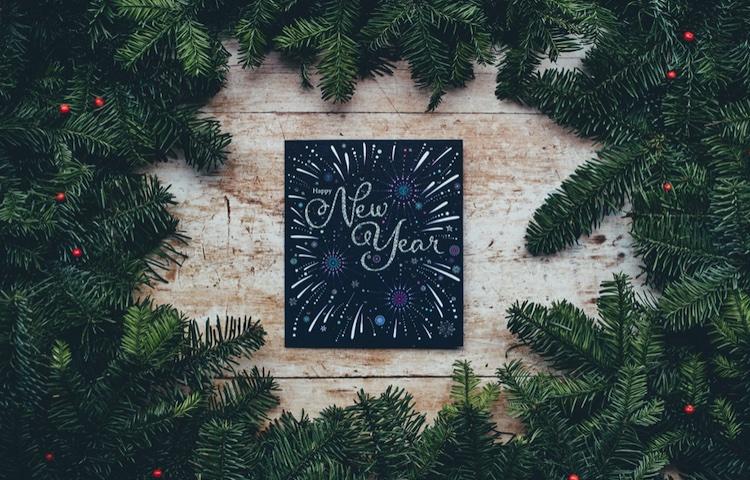Mindfulness is the art of paying open, non-judgmental attention from moment to moment. Since it is a practice of presence, what does it have to do with setting new year’s intentions or resolutions? Though mindfulness is indeed rooted in the present moment, what we discover through mindfulness practice can help us step into the future with greater peace, ease, and clarity.
This comprehensive guide to setting mindful new year’s resolutions explores:

How Mindfulness Shapes Our Future
Mindfulness is about practicing presence and about setting aside (or minding) any mental preoccupation with the past or the future. With that said, mindfulness of the present moment can shape our future by increasing self-awareness. As we enhance our awareness of how we feel and what is important to us, we are empowered to act in ways aligned with our highest intentions.
For example, mindfulness of eating can help us to become more aware of how certain foods and drinks nourish or deplete us. As we tune into this awareness with compassion and non-judgment, we will likely find that our consumption habits begin to shift.
Likewise, mindfulness of our thoughts and emotions can help us to gain insight into what it is we most authentically long for. Do we wish for more openness and connection in our lives? Do we wish for a greater sense of strength and resilience? Once we become aware of our heartfelt yearnings, we can take small or large steps to more deeply embody these qualities.
Mindfulness can also help to shape our future by:
So while mindfulness occurs in the present moment, it offers us the skills and insights required to step forward with greater clarity and equanimity.
LISTEN: Positive Future Meditation with Sean Fargo

“Be mindful of intention. Intention is the seed that creates our future.”
- Jack Kornfield -
The Difference Between New Year’s Resolutions and New Year’s Intentions
Setting new year’s resolutions is something that many of us do as the end of December approaches. In truth, however, we can set resolutions for ourselves at any time of the year. We need not wait until January rolls around.
But what is a resolution? And how do resolutions differ from intentions? The difference may seem to be semantic, but new year’s resolutions and new year’s intentions hold important distinctions.
New year’s resolutions are often:
For example: “I resolve to exercise four times per week in the new year.”
On the other hand, new year’s intentions are more typically:
For example: “I intend to cultivate more self-compassion in the year ahead of me.”
This example highlights the qualitative nature of intentions versus resolutions. By focusing on the quality or energy we long to embody or experience, we open ourselves to the many ways this might manifest.
Resolutions and intentions each have their place. At certain times of life, we may feel more drawn to one or the other. Take a moment’s pause now to consider:
What type of new year’s practice makes most sense for me in this moment?
Do I wish to set an intention, a resolution, or some kind of hybrid?
PRACTICE: What Do I Want For The Future?

6 Questions for New Year’s Intentions
If you feel drawn to explore new year’s intentions, consider the following six reflections and questions to mindfully explore what you wish to welcome into your new year. You can sit with these questions in meditation or you can use them as journal prompts.
From these questions, you might start to gain a clearer sense of what you intend to bring forth in the coming year. Once you have an intention in mind, repeat it to yourself in meditation or write it down in a journal. Take as long as you need to explore these questions or consider the following step by step guide to setting new year’s resolutions. This guide applies to setting mindful intentions, too.
LISTEN: Set Intentions for the New Year


“The future depends on what you do today.”
- Mahatma Gandhi -
How to Set Mindful New Year’s Resolutions: Step by Step
To set mindful new year’s resolutions, set aside some time to explore your heart’s intentions. Consider the following steps to bring greater mindfulness to the new year’s resolutions you might be setting this year.
1. Find a quiet space to rest in mindful contemplation.
Honour the symbolism of the new year by creating a comfortable space to mindfully reflect upon where you wish to go in the coming year. Light a candle, get comfortable, and have a pen and journal by your side.
Before diving into your vision for the new year, take a few minutes to practice mindful breathing. Close your eyes, let your shoulders and hands relax, and focus on your breath for at least ten cycles.
2. Reflect upon your heart’s intent.
Now, take some time to reflect upon your heart’s intent. This can be done whether you plan to set an actionable goal or a more qualitative intention for the new year. For instance, if you are resolving to exercise four times per week beginning in January, what is the intention behind this?
Perhaps you long to honour and nourish your body more deeply. Perhaps you wish to cultivate feelings of strength, vitality, and health. No matter what our surface goals might be, there are deeper yearnings that live beneath them.
Spend some quality time reflecting on what it is you most authentically long for. You can spend anywhere from five to fifteen minutes with this. Then, clarify your intention or resolution by repeating it in your mind three times. If you come up with more than one intention, this is of course welcome.

3. Witness competing thoughts and beliefs.
Once you have clarified your aspirations for the new year, notice any competing thoughts or beliefs that might arise. For instance, you might notice a thought that says it will be too difficult to live out your intentions. Observe any inner resistance or competing needs, tending to them with curiosity and compassion.
Furthermore, be mindful that even if there is little resistance inside of you now, our thoughts and feelings can change as quickly as the tide. Remember this so that you are not thrown off when the feelings you have tomorrow do not seem to match up with how you are feeling today. Tune back into your heart’s deepest longings so that you can remain grounded in your intentions despite your mental waves.
LISTEN: Working With Your Inner Critic with Mark Coleman
4. Reaffirm your intention or resolution through words.
You can support your dreams for the coming year by reaffirming your intention or resolution through words. Consider the following four ways of doing this.
I. Journal.
Write down your reflections about your heart’s intentions. What is it that has brought you to where you are now? What values are inspiring your visions? When you are finished journaling, clarify your intention or resolution statement once again by writing it down three times.
II. Practice affirmation meditation.
Once you’ve clarified your new year’s vision, sit in meditation for five to ten minutes while repeating your resolution. You can also shorten it by rewording your intention in present form. For example, if you long for increased equanimity in the new year, you might repeat: “I embody equanimity… I embody equanimity… I embody equanimity.”
III. Choose a word for the year.
You can simplify your resolution or intention even further by choosing a word to carry with you throughout the year. Equanimity, presence, compassion, courage, creativity, authenticity, and trust are examples of words you might choose from. Let your word be inspired by your heart’s intention.
IV. Share with a loved one.
External support from someone we love and trust is invaluable. After you finish this practice, share what you’ve been reflecting on with someone who can support and uplift you on your more difficult days. Inquire about their own dreams and aspirations for the new year.
5. Cultivate patience and compassion.
Finally, as you step into the new year with your mindful resolution held in heart and mind, remember to be gentle with yourself. There will be days that you get thrown off course, whether you’ve set an actionable goal or a qualitative intention to guide you. Embrace the fullness of your humanity, knowing that every single breath is a chance to begin again.
Download 300+ mindfulness worksheets to further enhance self-awareness.
Key Takeaways
References:
- 1Dolan E. New research indicates mindfulness meditation training can facilitate cognitive control. PsyPost. https://www.psypost.org/2020/04/new-research-indicates-mindfulness-meditation-training-can-facilitate-cognitive-control-56332. Published 2020.
- 2Grecucci A, Pappaianni E, Siugzdaite R, Theuninck A, Job R. Mindful Emotion Regulation: Exploring the Neurocognitive Mechanisms behind Mindfulness. Biomed Res Int. 2015;2015:670724. doi:10.1155/2015/670724
- 3Kiken LG, Shook NJ. Looking Up: Mindfulness Increases Positive Judgments and Reduces Negativity Bias. Social Psychological and Personality Science. 2011;2(4):425-431. doi:10.1177/1948550610396585
- 4Sun S, Yao Z, Wei J, Yu R. Calm and smart? A selective review of meditation effects on decision making. Front Psychol. 2015;6:1059. Published 2015 Jul 24. doi:10.3389/fpsyg.2015.01059



















